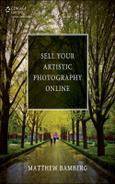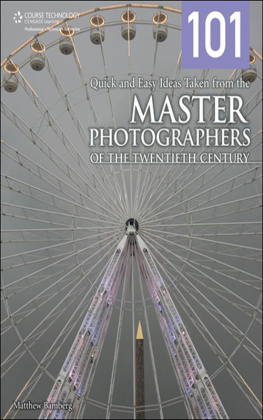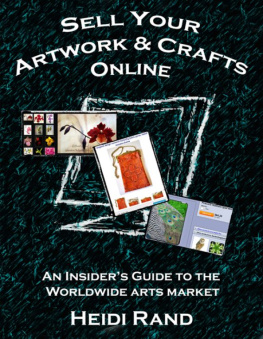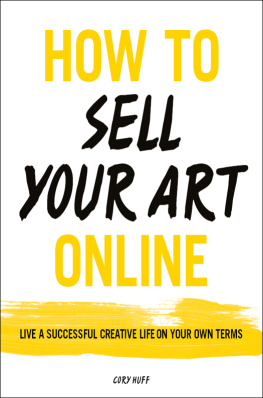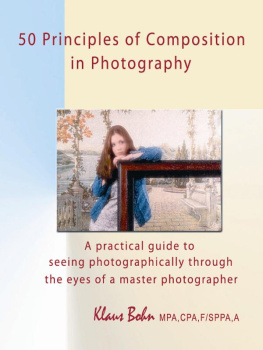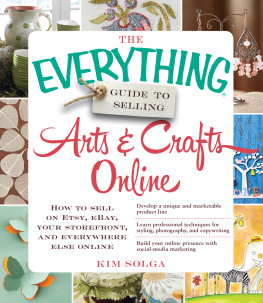Sell Your Artistic Photography Online
Matthew Bamberg
Cengage Learning PTR


Sell Your Artistic Photography Online
Matthew Bamberg
Publisher and General Manager, Cengage Learning PTR:
Stacy L. Hiquet
Associate Director of Marketing:
Sarah Panella
Manager of Editorial Services:
Heather Talbot
Acquisitions Editor:
Dan Gasparino
Senior Marketing Manager:
Mark Hughes
Technical Editor:
Christina Kanaras
Interior Layout:
Shawn Morningstar
Cover Designer:
Luke Fletcher
Proofreader:
Kelly Talbot Editing Services
2014 Cengage Learning PTR.
CENGAGE and CENGAGE LEARNING are registered trademarks of Cengage Learning, Inc., within the United States and certain other jurisdictions.
ALL RIGHTS RESERVED. No part of this work covered by the copyright herein may be reproduced, transmitted, stored, or used in any form or by any means graphic, electronic, or mechanical, including but not limited to photocopying, recording, scanning, digitizing, taping, Web distribution, information networks, or information storage and retrieval systems, except as permitted under Section 107 or 108 of the 1976 United States Copyright Act, without the prior written permission of the publisher.
For product information and technology assistance, contact us at
Cengage Learning Customer & Sales Support, 1-800-354-9706
For permission to use material from this text or product,
submit all requests online at cengage.com/permissions
Further permissions questions can be emailed to
permissionrequest@cengage.com
All trademarks are the property of their respective owners.
All images Cengage Learning unless otherwise noted.
ISBN-13: 978-1-285-86623-9
ISBN-10: 1-285-86623-1
Cengage Learning PTR
20 Channel Center Street
Boston, MA 02210 USA
Cengage Learning is a leading provider of customized learning solutions with office locations around the globe, including Singapore, the United Kingdom, Australia, Mexico, Brazil, and Japan. Locate your local office at: international.cengage.com/region.
Cengage Learning products are represented in Canada by Nelson Education, Ltd.
For your lifelong learning solutions, visit cengageptr.com.
Visit our corporate Web site at cengage.com.
To Todd Larson
Acknowledgments
The author would like to thank his agent Carole Jelen and editors Kezia Endsley and Daniel Gasparino. His gratitude also extends to the many fine art photography print-on-demand websites that have enabled thousands of artists to present and sell their images online. He would also like to thank his friends and familyTodd Larson, Louis Bamberg, Andrea Bamberg, Alan Bamberg, Alicia Bamberg-Rech, Eli Bamberg, Suellen Evavold, Phyllis Larson, and Victor Rechfor always being there when involved in a creative project.
About the Author
Ten years ago, Matthew Bamberg provided photographs along with his articles and columns for Southern California newspapers and magazines, including The Desert Sun (Palm Springs) and the Press-Enterprise (Riverside). As a freelance contributor, he wrote about art, popular culture, entertainment, travel, and local religious congregations, including a popular One Tank Trip weekend travel column. In the last few years Matt has authored a number of books and taught writing, education, and photography at several universities, including The History of Fine Art Photography at the University of California in Riverside. He is the author of the Quick and Easy Secrets book series (Cengage), Beginning HDR Photography, Photography Applications for Cloud Computing, Killer Photos with Your iPhone (with Kris Krug and Greg Ketchum, Cengage), The 50 Greatest Photo Opportunities in San Francisco (Cengage), and Digital Art Photography for Dummies (Wiley). Matt is also a professor at National University and Ashford University, where he instructs in teaching methods and writing.
Contents
Part 1
The Fine Art Photography Scoop
Chapter 1
Defining Fine Art Photography Today
Chapter 2
History of Fine Art Photography
Chapter 3
Microstock versus Fine Art Photography
Chapter 4
Fine Art Photography Online
Part 2
Fabulous FilmTheres No Other Media Like It
Chapter 5
Selling Prints, Slides, and Negatives
Chapter 6
The Ins and Outs of Scanning
Chapter 7
Restoring Vintage Photos
Part 3
Digital Photography
Chapter 8
Shooting and Composition
Chapter 9
Color and Light in Fine Art Photography
Chapter 10
Finding Your Niche
Chapter 11
Finding What Sells
Chapter 12
Postprocessing
Chapter 13
Resolution and Sensor Size
Part 4
Digital Art
Chapter 14
Digital Art Defined
Chapter 15
Making a Photograph Look Like a Painting
Chapter 16
Making a Photograph Look Like a Drawing
Chapter 17
Creating a Matching Background
Chapter 18
Creating High Dynamic Range (HDR) Photos
Part 5
Selling Fine Art Photography Online
Chapter 19
Whats Selling
Chapter 20
Fine Art America
Chapter 21
Artist Rising
Chapter 22
Imagekind
Part 6
Gallery
Introduction
Fine art photography, a medium that has been around for over a century, has blossomed from a world of black-and-white film images of stunning portraits and scenes practiced by a few esoteric masters to a worldwide online revolution of the masses. The meaning of art, the work of the artist-photographer, and the landscape of commerce isnt anything like it was once when film was king.
An eternal quest for discovering the smallest devices that produce the sharpest images has evolved at lightning speed, continuing to do so into the unforeseeable future. Over a century ago, cameras were hundreds of times larger than the smallest of those manufactured today. As time passes, each new step in technology not only provides better photography, but also is merging with other forms of communication and multimedia. These include camera phones, cameras once used for still photography being upgraded so that they shoot video, and video that can be turned to stills with the click of a button. These options give the photographer a wide gamut of images from which to choose more image choices than ever before.
Photography commerce stands in the shadow of the medium, progressing right behind it. Selling print images on the ground years ago involved complicated photography shooting, film developing, and print advertising. Today, the development of cameras, computers, and the Internet has created a bustling commerce that involves millions of people as opposed to the thousands who participated in creating and selling photography decades before.

